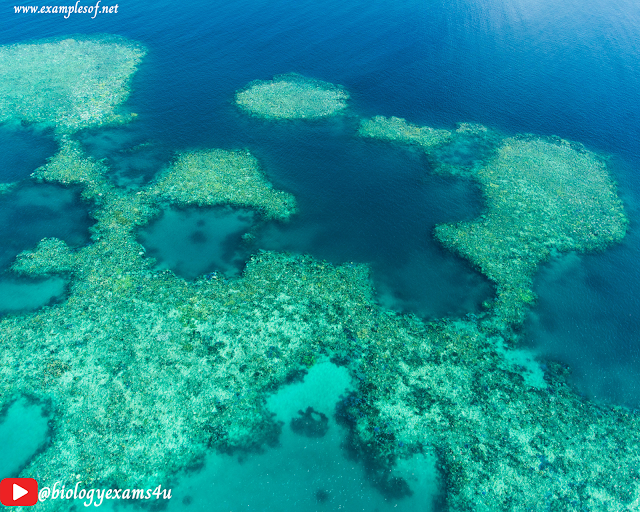Corals are animals belonging to the phylum
Coelenterata (Cnidaria). These corals secrete an exoskeleton formed
of calcium carbonate, which protects the soft body. Generally, this
exoskeleton is called coral. The corals in general have diverse shapes and
sizes, but majority are colonial with very small polyps. Coral colonies are
most abundant in tropical seas, through some occur in arctic and temperate seas
and most of them flourish at a temperature above 220 C.
Examples: Fungia, Favia and Madrepora
Two
special corals: -black corals (Antipathes) and the precious red corals (Corallium)
develop based calcium-based skeleton. They build skeleton with much different
crystal geometrics. The unique mineral formed by these corals makes them prized
for jewellery making. These corals are endangered due to discriminate
collecting by divers.
Corals
grow very slowly. The dense solid corals which build reefs grow less than one
to two cms each year. When these organisms die their skeleton forms extensive
mounds of lime in the sea. These are called coral reefs.
A
coral reef is a complex living community in which reef building corals create a
physical environment where many other plants and animals thrive. A coral reef
takes thousands of years to form. One pound of coral may contain over 37,000
polyp skeletons. Coral reefs are in inhabited by a number of sponges, sea
anemones, sea urchins, starfishes, crabs, bivalves etc. The other components in
the formation of coral reefs are Tubipora, Millepora, Heliopora, Gorgonians,
Alcyonaria, Foraminifera, coralline algae and branching algae.
Types
of Coral Reefs
There
are general types of reefs can be recognized on the basis of their structure
and underlying substratum. They are of four types:
1. Fringing Reefs
2. Barrier Reefs
3. Atoll Reefs
4. Patch reef

1. Fringing Reef: They are also known as the shore reefs and built from the sea bottom and project seaward directly from the shore. They are most common type of reef throughout the world. Abundant in East Indies. The zones of the sea between the shore and reef is very shallow. The seaward edge of the reef platform is called reef edge, where the most active coral growth is observed.
2.
Barrier Reef: The
barrier reefs are similar to fringing reefs, but they are situated in the sea
about 1 to 15 km away from shore. The zone of the sea between the shore and
reef is very deep and hence navigable. The great barrier reef of
Australia is the longest in the world: stretching on the north east coast
of Australia, is 1200 miles long, 20 to70 miles wide and situated nearly 90
miles away from the shore. Another relatively long barrier reef is located in
the Caribbean Sea off the coast of Belize between Mexico and
Guatemala.
The barrier reef consists of same parts
as the fringing reef, but the place of inner flat is taken by the lagoon flat.
The latter has a thin covering of sand and shows an extraordinary luxuriant
coral growth.

3.
Atoll Reef: It
is also known as coral island or lagoon island, is a circular or horseshoe
shaped reef enclosing a lagoon of water which may be small or large up to 50
miles across.
Over 300 atolls are present in the
Indo-Pacific, but only 10 are found in the Western Atlantic. Bermuda of
Atlantic, Aldabra in the Indian Ocean, Lakshadweep islands are examples.

4. Patch reef

Importance or Conservation
of Coral Reef
The coral reef is a balanced system
where all things have their own special place and function. The coral reef
ecosystem maintains the fertility of the surrounding waters by providing waste
materials and nutrients. The abundant, unique and colourful animal life it
supports contribute a treasure house of biological wealth.
Reefs are important source of seafood. The reef offers shelter and feeding grounds to many types of fishes and other animals. Reef act as barriers which protests our beaches and shorelines from powerful ocean waves and currents.
